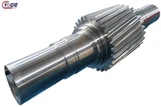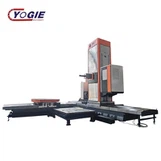Rail Wheel
Products Description
A rail wheel is a type of wheel specifically designed for use on rail tracks. Rail wheels are typically made of steel and are cylindrical in shape, with a diameter that is usually between 28 and 36 inches. They are used on trains and other railway vehicles to support the weight of the vehicle and to provide traction on the tracks.
Rail wheels are designed to withstand heavy loads and to roll smoothly and evenly along the tracks. They are also designed to withstand the forces of braking and acceleration, as well as the lateral forces that can occur when a train is turning. In addition, rail wheels are often fitted with flanges, which help to keep the train on the tracks and prevent derailment.
Products show

The features of rail wheel

►Material:
Rail wheels are typically made of steel, which provides strength and durability to withstand the heavy loads and forces encountered on railway tracks.
►Diameter:
The diameter of a rail wheel is usually between 28 and 36 inches, which allows it to roll smoothly and evenly along the tracks.
►Shape:
Rail wheels are cylindrical in shape, with a slightly tapered profile to provide stability and reduce wear on the wheel and the track.
►Flanges:
Most rail wheels have flanges, which are raised rims on the inside of the wheel that help to keep the train on the tracks and prevent derailment. The flanges also help to distribute the weight of the train more evenly along the track.
►Axle:
Rail wheels are mounted on axles, which are supported by bearings that allow the wheels to rotate freely. The axle is an important component of the wheelset, which includes the wheel, axle, and bearings.
►Tread:
The tread of a rail wheel is the surface that comes into contact with the track. It is typically slightly conical in shape to provide stability and reduce wear on the wheel and the track.
►Maintenance:
Rail wheels require regular inspection and maintenance to ensure that they are in good working condition. This includes monitoring the tread profile, checking for cracks or other damage, and measuring the wheel diameter to ensure that it is within specifications.
Machinery processing of rail wheel
►Forging: The first step in the manufacturing process is forging, where the steel billet is heated and shaped into a rough wheel shape using a press or hammer.
►Rolling: The rough wheel shape is then rolled into a cylindrical shape using a rolling mill. This process involves passing the rough wheel through a series of rollers to compress and shape it.
►Heat treatment: The rolled wheel is then heat-treated to improve its strength and toughness. This involves heating the wheel to a specific temperature and then rapidly cooling it to create a hardened surface layer.
►Machining: The heat-treated wheel is then machined to its final dimensions and shape. This involves using lathes, milling machines, and other precision machinery to remove any excess material and create a smooth, uniform surface.
►Finishing: Finally, the wheel is finished with a protective coating or finish to improve its performance and durability. This may involve applying a layer of paint, plating, or other surface treatment.
Summary
Overall, the manufacturing process for rail wheels is complex and requires specialized machinery and expertise to ensure that the wheels meet the strict quality and safety standards required for railway applications.
Load capacity and Compatibility
Load Capacity
When considering the load capacity of rail wheels, it is crucial to determine the maximum weight that the wheels need to support. This includes both the static weight of the rolling stock (such as locomotives, freight cars, or passenger cars) and any dynamic forces that may be exerted during operation. It is essential to choose rail wheels that can safely handle the expected loads without compromising safety or causing excessive wear.
Compatibility
Compatibility is another vital factor when choosing rail wheels. Consider the following aspects of compatibility:
Track Gauge: Rail wheels must be compatible with the track gauge, which is the distance between the inner edges of the rails. Different rail systems have varying track gauges, such as standard gauge, broad gauge, or narrow gauge. Ensure that the rail wheels you choose are designed to fit the specific track gauge of your rail system.
Wheel Flange Clearance: The wheel flange clearance refers to the distance between the wheel flange and the inner surface of the rail. It is essential to consider the required wheel flange clearance based on your rail infrastructure. The clearance should be sufficient to allow smooth movement of the wheels within the rails without causing any interference or instability.
Mounting Requirements: Rail wheels need to be compatible with the mounting system used in your rail system. This includes the axle design and the method of attaching the wheels to the axles. Ensure that the rail wheels you select are designed to fit the specific mounting requirements of your rolling stock and axle system.
Operational Conditions: Consider the specific operational conditions in which the rail wheels will be used. This includes factors such as the type of track (curved or straight), the terrain (flat or hilly), and any specific environmental conditions (such as temperature, humidity, or exposure to corrosive substances). Choose rail wheels that are designed to withstand and perform well under the specific conditions of your rail system.
Summary
By considering both the load capacity and compatibility factors, you can ensure that the rail wheels you choose are capable of safely supporting the loads and are compatible with your rail infrastructure. This will help to ensure optimal performance, safety, and longevity of the rail wheels in your rail system.
Our products (wheels)

Cost-effectiveness of rail wheel
The cost-effectiveness of rail wheels can be evaluated by considering several factors, including the initial cost, operational costs, maintenance costs, and overall lifespan of the wheels. Here are some key points to consider:

Description
●Initial Cost: The cost of rail wheels varies depending on factors such as size, material, and manufacturing processes. Steel wheels are commonly used and are generally more cost-effective compared to other materials like aluminum. The initial cost of rail wheels is typically a fraction of the total cost of a rail system.
●Operational Costs: Rail wheels are designed to withstand high loads and provide long-term performance. They offer low rolling resistance, which helps reduce energy consumption and operational costs, especially for freight transport over long distances. Efficient wheel designs can result in fuel savings, lower maintenance requirements, and increased overall cost-effectiveness.
●Maintenance Costs: Rail wheels require regular maintenance to ensure optimal performance and safety. Maintenance costs include activities such as wheel profiling, grinding, and inspection for wear and damage. Effective maintenance practices can extend the lifespan of the wheels and reduce the need for premature replacements. However, maintenance costs can vary depending on the condition of the track, environmental factors, and the quality of maintenance programs implemented.
●Lifespan: Rail wheels are built to withstand heavy loads and endure for extended periods. The lifespan of rail wheels depends on various factors, including wheel design, material quality, track conditions, maintenance practices, and operational requirements. By using high-quality materials and proper maintenance, rail wheels can last for several years, making them cost-effective in the long run.
●Cost of Downtime: Rail systems can experience downtime due to wheel-related issues, such as flat spots, cracks, or excessive wear. Downtime can result in delays, reduced productivity, and increased costs. Investing in durable, reliable rail wheels can minimize downtime and its associated expenses.
Summary
Overall, rail wheels are considered cost-effective due to their long lifespan, low operational costs, and potential for energy savings. However, it's important to note that cost-effectiveness can vary based on individual circumstances, including the specific rail system, usage patterns, maintenance practices, and regional factors. Conducting a comprehensive cost-benefit analysis specific to the intended application would provide a more accurate assessment of the cost-effectiveness of rail wheels.
About US

Luoyang Yujie Industry &Trade Co.Ltd located in Luoyang City, one of the main heavy industrial bases in China. We specialize in the production of bearings, nonstandard machinery parts, machine tools. For the nonstandard machine parts, we can produce gears, shafts, sprockets, molds, rollers, pulley, mining machine parts, etc. As a manufacturer, we have rich experience and strong ablity to process products as per customer drawing and requirements.
Contact US
Do you have any specific questions about the rail wheel ? Contact Yogie! Our sales engineers will work with you from start to finish to ensure that your project is completed to your requirements.
![]()
tel: +86-379-65163600
![]()
phone: +86-15036387078
![]()
envelope: sales@yujieindustry.com
![]()
fax:+86-379-65163600
![]()
address:No. 9 Jingjin North Rd, Luoxin Development Zone, Xin'an County, Luoyang City, Henan Province,CN 471003
![]()
whatsapp: 8615036387078
Hot Tags: rail wheel, manufacturers, supplier, factory, customized, cheap, price, in stock, for sale

















